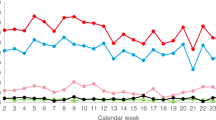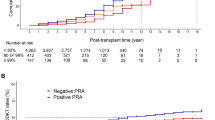Abstract
Despite over 20 million unrelated donors being listed worldwide, donor attrition at the confirmatory typing (CT) stage of donor acquisition is a key source of delay. Anthony Nolan undertook a study of CT requests from 2010 to 2011 to identify factors associated with attrition. Of 7541 CT requests, 38.2% were cancelled for donor reasons. Of these, 19.4% were personal, 34.1% medical, 36% no contact, 7.9% emigrated and 2.6% others. African (odds ratio (OR) 2.78, P<0.001), African-Caribbean (OR 3.07, P<0.001), Asian (OR 2.65, P<0.001), Jewish (OR 1.54, P=0.009) and Mediterranean (OR=2.38, P<0.001) donors were more likely not to be available compared to Caucasian donors. Female donors were also more likely not to be available (OR=1.32, P<0.001): primarily due to pregnancy. Older donors were less likely to be available in univariate analysis, but this association was not significant after controlling for other factors. Blood donors and those recruited within the past five years had lower rates of attrition. Accumulation of additional attrition-associated characteristics for a given donor was associated with progressively greater odds of attrition (OR 1.99, 2.52, 3.4 and 5.53, respectively, for 1, 2, 3 and 4 risk factors, P<0.001). Donor registries must develop evidence-driven strategies to recruit and retain the most reliable donors.
This is a preview of subscription content, access via your institution
Access options
Subscribe to this journal
Receive 12 print issues and online access
$259.00 per year
only $21.58 per issue
Buy this article
- Purchase on Springer Link
- Instant access to full article PDF
Prices may be subject to local taxes which are calculated during checkout




Similar content being viewed by others
References
Cleaver SA . The Anthony Nolan Research Centre. Bone Marrow Transplant 1993; 11 (Suppl 1): 38–40.
Passweg JR, Baldomero H, Gratwohl A, Bregni M, Cesaro S, Dreger P et al. The EBMT activity survey: 1990-2010. Bone Marrow Transplant 2012; 47: 906–923.
Switzer GE, Bruce JG, Myaskovsky L, Dimartini A, Shellmer D, Confer DL et al. Race and ethnicity in decisions about unrelated hematopoietic stem cell donation. Blood 2012; 121: 1469–1476.
Bone Marrow Donors Worldwide. http://www.bmdw.org (accessed on 1st May, 2013).
Sencer SF, Zhou T, Freedman LS, Ives JA, Chen Z, Wall D et al. Traumeel S in preventing and treating mucositis in young patients undergoing SCT: a report of the Children’s Oncology Group. Bone Marrow Transplant 2012; 47: 1409–1414.
Craddock C, Labopin M, Pillai S, Finke J, Bunjes D, Greinix H et al. Factors predicting outcome after unrelated donor stem cell transplantation in primary refractory acute myeloid leukaemia. Leukemia 2011; 25: 808–813.
Heemskerk MB, van Walraven SM, Cornelissen JJ, Barge RM, Bredius RG, Egeler RM et al. How to improve the search for an unrelated haematopoietic stem cell donor. Faster is better than more!. Bone Marrow Transplant 2005; 35: 645–652.
Lown RN, Shaw BE . 'First do no harm': where do we stand on unrelated hematopoietic cell donor safety? Expert Rev Hematol 2012; 5: 249–252.
Abress L . Retention Strategies. http://www.worldmarrow.org/fileadmin/Committees/EDUC/2011-EDUC/20111103-EDUC-Donor_Retention_NMDP.pdf (accessed on 1st May, 2013).
Switzer GE, Dew MA, Stukas AA, Goycoolea JM, Hegland J, Simmons RG . Factors associated with attrition from a national bone marrow registry. Bone Marrow Transplant 1999; 24: 313–319.
Werzner ASU, Stolze J, Cotta L, Schmidt A, Ehninger G Patient-Related Donor Recruitment Increases Donor Availability On CT Level, http://www.worldmarrow.org/fileadmin/Committees/EDUC/2012-EDUC/20121108-EDUC-Abstracts_Edu_day.pdf (accessed on 16th December, 2013).
Chen AI, Negrin RS, McMillan A, Shizuru JA, Johnston LJ, Lowsky R et al. Tandem chemo-mobilization followed by high-dose melphalan and carmustine with single autologous hematopoietic cell transplantation for multiple myeloma. Bone Marrow Transplant 2012; 47: 516–521.
Direkze S, Mansour M, Rodriguez-Justo M, Kibbler C, Gant V, Peggs KS . Candida kefyr fungal enteritis following autologous BMT. Bone Marrow Transplant 2012; 47: 465–466.
Switzer GE, Myaskovsky L, Goycoolea JM, Dew MA, Confer DL, King R . Factors associated with ambivalence about bone marrow donation among newly recruited unrelated potential donors. Transplantation 2003; 75: 1517–1523.
Schmidt AH, Biesinger L, Baier D, Harf P, Rutt C . Aging of registered stem cell donors: implications for donor recruitment. Bone Marrow Transplant 2008; 41: 605–612.
Muller CR, Ehninger G, Goldmann SF . Gene and haplotype frequencies for the loci hLA-A, hLA-B, and hLA-DR based on over 13 000 German blood donors. Hum Immunol 2003; 64: 137–151.
Kollman C, Abella E, Baitty RL, Beatty PG, Chakraborty R, Christiansen CL et al. Assessment of optimal size and composition of the US National Registry of hematopoietic stem cell donors. Transplantation 2004; 78: 89–95.
Laver JH, Hulsey TC, Jones JP, Gautreaux M, Barredo JC, Abboud MR . Assessment of barriers to bone marrow donation by unrelated African-American potential donors. Biol Blood Marrow Transplant 2001; 7: 45–48.
Ballen KK, Hicks J, Dharan B, Ambruso D, Anderson K, Bianco C et al. Racial and ethnic composition of volunteer cord blood donors: comparison with volunteer unrelated marrow donors. Transfusion 2002; 42: 1279–1284.
Schmidt AH, Solloch UV, Baier D, Yazici B, Ozcan M, Stahr A et al. Criteria for initiation and evaluation of minority donor programs and application to the example of donors of Turkish descent in Germany. Bone Marrow Transplant 2009; 44: 405–412.
Author information
Authors and Affiliations
Corresponding author
Ethics declarations
Competing interests
The authors declare no conflict of interest.
Rights and permissions
About this article
Cite this article
Lown, R., Marsh, S., Switzer, G. et al. Ethnicity, length of time on the register and sex predict donor availability at the confirmatory typing stage. Bone Marrow Transplant 49, 525–531 (2014). https://doi.org/10.1038/bmt.2013.206
Received:
Revised:
Accepted:
Published:
Issue Date:
DOI: https://doi.org/10.1038/bmt.2013.206
Keywords
This article is cited by
-
A real-life overview of a hematopoietic cell transplant program throughout a four-year period, including prospective registry, exclusion causes and final donor selection
Bone Marrow Transplantation (2022)
-
Differential admixture, human leukocyte antigen diversity, and hematopoietic cell transplantation in Latin America: challenges and opportunities
Bone Marrow Transplantation (2020)
-
Efficiency of allogeneic hematopoietic SCT from HLA fully-matched non-sibling relatives: A new prospect of exploiting extended family search
Bone Marrow Transplantation (2015)



